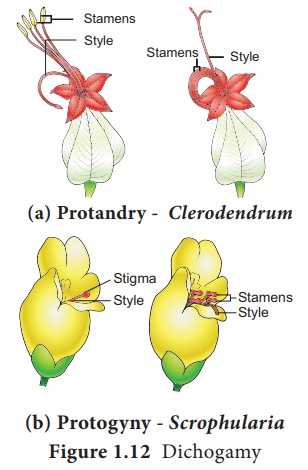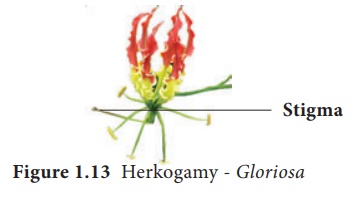Sexual Reproduction in Plants - Cross - pollination | 12th Botany : Chapter 1 : Asexual and Sexual Reproduction in Plants
Chapter: 12th Botany : Chapter 1 : Asexual and Sexual Reproduction in Plants
Cross - pollination
Cross – pollination
It refers to the
transfer of pollens on the stigma of another flower. The cross-pollination is
of two types:
i. Geitonogamy: When the pollen
deposits on another flower of the same individual plant, it is said to
be geitonogamy. It usually occurs in plants which show monoecious condition. It
is functionally cross-pollination but is similar to autogamy because the pollen
comes from same plant.
ii. Xenogamy: When the pollen
(genetically different) deposits on another flower of a different plant
of the same species , it is called as xenogamy.
Contrivances of
cross-pollination
The flowers of the
plants have also several mechanisms that promote cross-pollination which are
also called contrivances of cross-pollination or outbreeding devices. It
includes the following.
1. Dicliny or
Unisexuality
When the flowers are
unisexual only cross-pollination is possible. There are two types.
i. Monoecious:
Male and female flowers on the same plant. Coconut, Bitter gourd. In plants
like castor and maize, autogamy is prevented but geitonogamy takes place.
ii. Dioecious : Male and female
flowers on different plants. Borassus, Carica papaya and
date palm. Here both autogamy and geitonogamy are prevented.
2. Monocliny or
Bisexuality
Flowers are bisexual and
the special adaptation of the flowers prevents self-pollination.
i. Dichogamy: In bisexual flowers
anthers and stigmas mature at different times, thus checking
self-pollination. It is of two types.
a. Protandry: The stamens mature
earlier than the stigmas of the flowers. Examples: Helianthus,
Clerodendrum (Figure 1.12 a).
b. Protogyny: The stigmas mature
earlier than the stamens of the flower. Examples: Scrophularia nodosa
and Aristolochia bracteata (Figure 1.12 b).

ii. Herkogamy: In bisexual flowers
the essential organs, the stamens and stigmas, are arranged in such a
way that self-pollination becomes impossible. For example in Gloriosa superba,
the style is reflexed away from the stamens and in Hibiscus
the stigmas project far above the stamens (Figure 1.13).

iii. Heterostyly: Some plants produce two
or three different forms of flowers that are different in their length of
stamens and style. Pollination will take place only between organs of the same
length.(Figure 1.14)
a. Distyly: The plant produces two
forms of flowers, Pin or long style, long stigmatic papillae, short
stamens and small pollen grains;
Thrum-eyed or short
style, small stigmatic papillae, long stamens and large pollen grains. Example:
Primula (Figure 1.14a). The stigma of the Thrum-eyed flowers and the
anther of the pin lie in same level to bring out pollination. Similarly the
anther of Thrum-eyed and stigma of pin ones is found in same height. This helps
in effective pollination.

b. Tristyly: The plant produces
three kinds of flowers, with respect to the length of the style and
stamens. Here,the pollen from flowers of one type can pollinate only the other
two types but not their own type. Example : Lythrum (Figure 1.14b).
iv. Self
sterility/ Self- incompatibility: In some
plants, when the pollen grain of a flower reaches the stigma of the same, it is
unable to germinate or prevented to germinate on its own stigma. Examples: Abutilon,
Passiflora. It is a genetic mechanism.
Related Topics